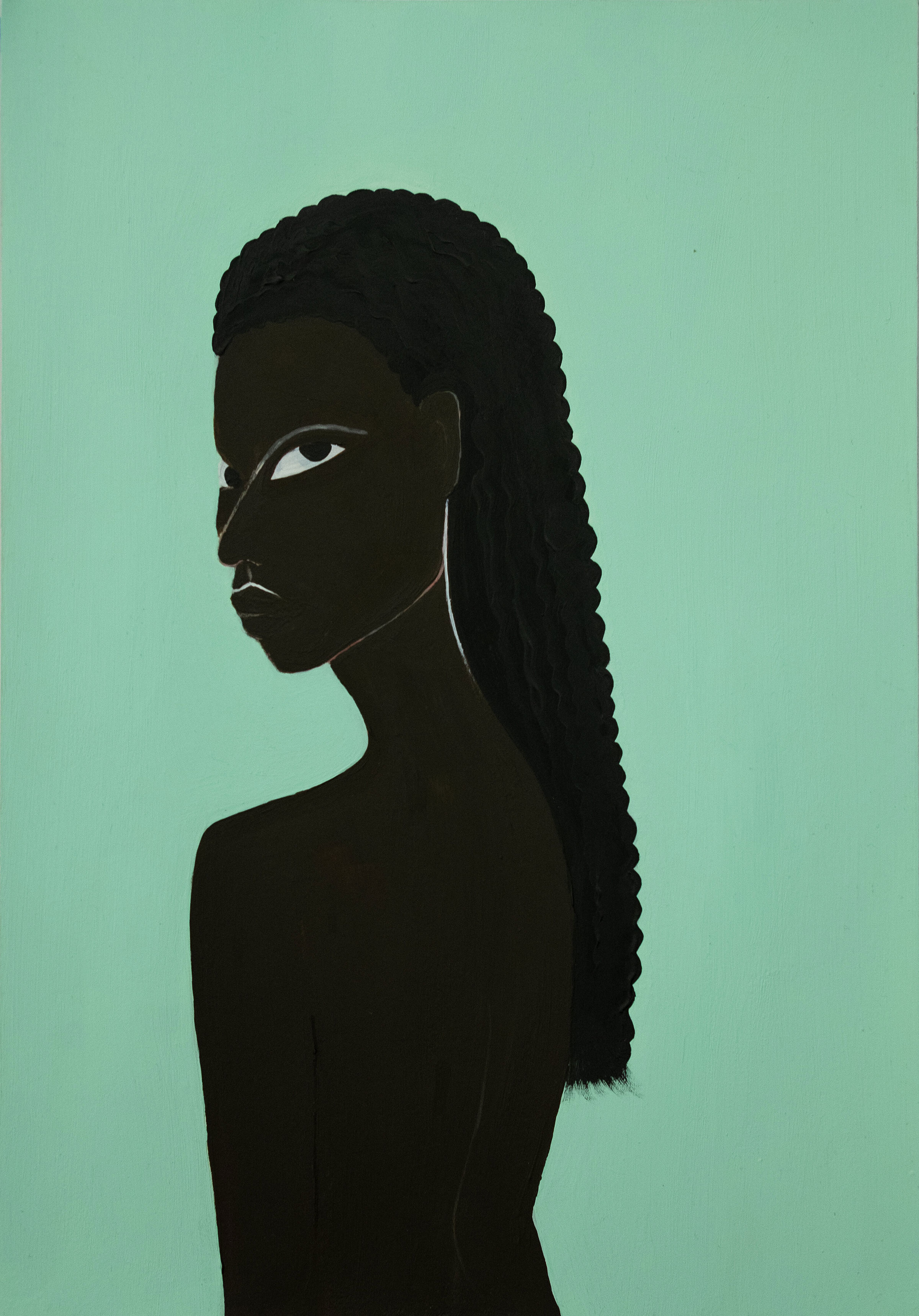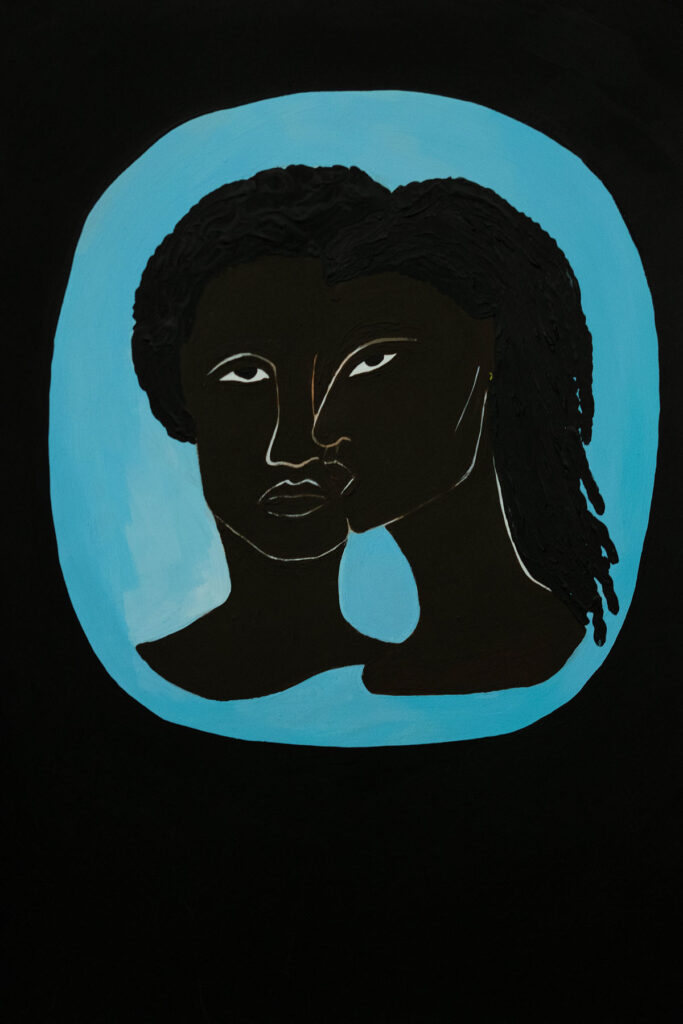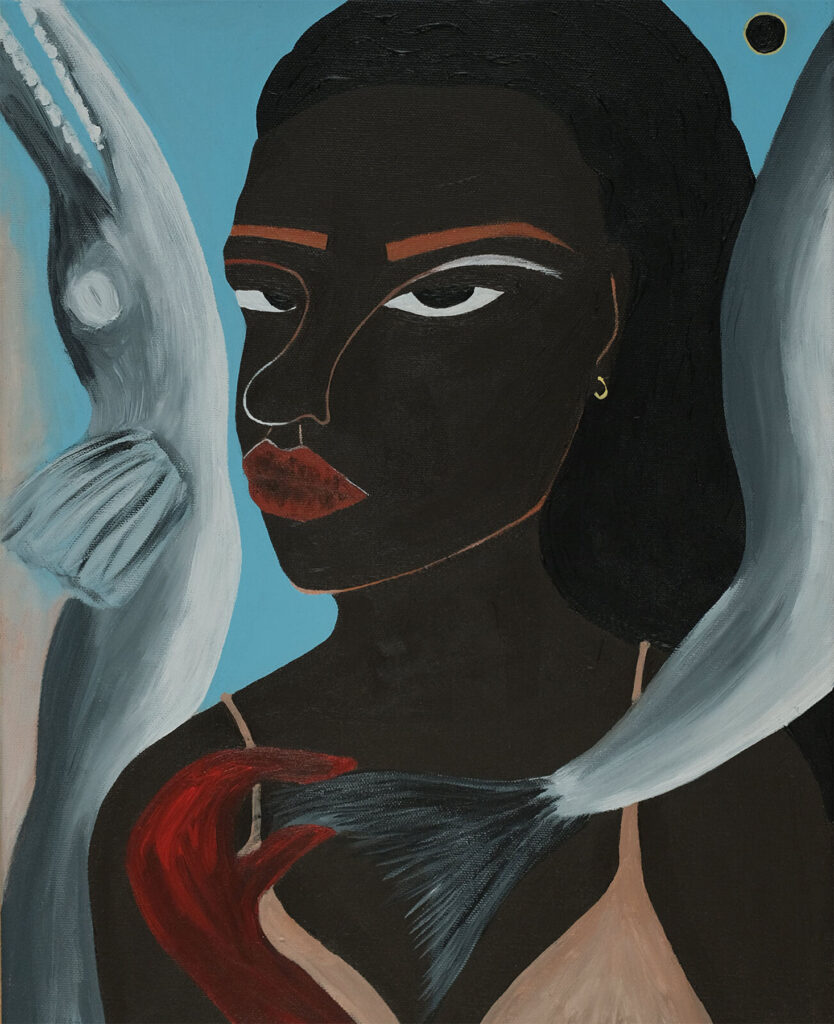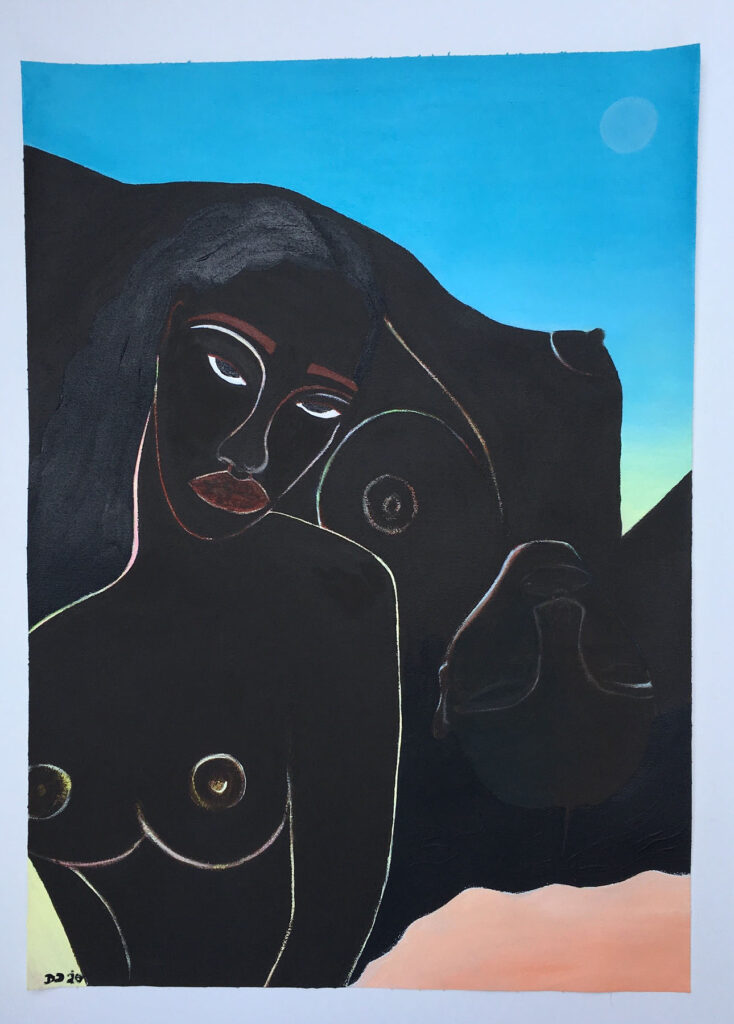Delphine Desane

An Honest Narrative of The Painter’s Experiences as a Black Woman
Delphine Desane began painting three years ago whilst on maternity leave from her career working as a fashion stylist. As she describes below, becoming a mother had a profound effect on Delphine – that much is evident from a painting of hers of a mother, stood, undeterred, her infant child positioned on her hip. That piece was, as it happens, a Dior editorial of sorts for Vogue Italia’s January issue. Look closely and you can feel the tulle of the sheer dress that hangs elegantly off of Delphine’s subject; the floral embroidery is beautifully replicated, capturing the essence of femininity that Maria Grazia Chiuri has become synonymous with. And it’s the small details in Delphine’s portraits that make them so special – take Georgia, Mother of Three (2020), for example, in which a translucent, gold hoop earring hugs the character’s ear; an understated marker of who Georgia, as Delphine christens her, is. Ultimately, however, Georgia is much more than a single, definable character. She is, as Delphine explained in an interview earlier this year with the CFHILL gallery in Stockholm, ‘a black woman, she is a mother, she has children but also she has identified herself as a woman and not just a mother.’ The characters that Delphine paints are a coalescence of memories, experiences and photographs – never placeable in a space or moment in time (except, perhaps, for the tell-tale signs of that Dior SS20 dress in Motherhood), but rather, entirely timeless. Her use of striking, bold colours as backdrops are a deliberate tactic to focus attention on each character’s expressions – the simple features that are signature of Delphine’s style managing to convey strong, powerful emotions. Though, it’s worth noting too, that Oaxaca is a place Delphine describes as having a massive influence on her work. Since a friend moved there five years ago, she’s visited the Mexican city several times. ‘There is so much creativity and beauty in this town, indigenous, ancestral and modern at the same time. The places I visit are usually the starting point of my creative process – it helps me create a fictional story around it, and place a character into it.’
Growing up in Paris, to Haitian-born parents, and now based in Brooklyn, Delphine’s portraits are gorgeous depictions of black womanhood that are rarely found in a large-scale, mainstream way. Speaking to CFHILL (Georgia and two other paintings were included in the gallery’s group show Black Voices / Black Microcosm), she remarked that, ‘As an artist, you should try to highlight what you want society to see through your eyes.’ Through her painting, Delphine has found the space to create loving works that present an honest narrative to her experiences as a black mother, a black woman and as the immigrant child of immigrants themselves. Following Vogue Italia’s Sustainability Issue in January, for which Delphine was commissioned alongside six other artists to create an illustrated cover of the magazine as a statement against the environmental impact of photoshoots, she appeared, herself, on the magazine’s September Issue. ‘Hope’, it was called, with 100 covers of 100 people, telling 100 stories; Delphine was number 58. Of the many reasons that 2020 will be remembered, the inventive and creative ways in which magazines have responded to sustainability, coronavirus, Black Lives Matter and so on, will be one of the positives. And to see Delphine, a painter whose career transformed almost overnight following that first magazine cover, be recognised as an emerging artist is certainly another positive to come from this year too. ‘We’ve been under quarantine for half of the year. My work has been shown for the first time this year in January, my first group show at CFHILL was in February, and most people haven’t even seen my work in real life but still, the majority relate to it.’ Letting the work speak for itself has always been her goal, however. As the year draws to a close, Delphine finds herself working on her first solo show at the Luce Gallery in Turin, scheduled to open in December.

What inspired you to begin painting? Is it something you had a background in already?
Becoming a mother really inspired me to start painting. There is a big switch that happens when you become a parent – you have to experience it to really understand what I mean. You are no longer alone, you become responsible for another human being. And, as a mother specifically, a new life physically comes out of your body. My life changed drastically after the birth of my son; finding a new purpose in life. What truly fulfilled me became my priority, and it turns out, painting came naturally.
I don’t have a background in painting; I attended a fashion school in Paris called Le Studio Berçot which operates more like an atelier than a class school. There wasn’t a grading system, for example. And believe it or not, I was not good at drawing – at all. I had never taken an anatomy class, and was better at making things with my hands like knitting, weaving, embroidering and collage. Most of all, I enjoyed storytelling which is what led me to going on to work in the editorial side of fashion. My mother sewed and knitted a lot at home – I don’t have a memory of her not working on something, and I learned how to sew with her at home before my studies.

Has your background working in fashion influenced your art?
Absolutely: I have worked in the industry for 10+ years and I have had the chance to work with amazing artists, before I could even call myself one. My photographic eyes and strength for composition comes from these intense, formative years – watching and working with artists like Rineke Dijkstra, Gillian Wearing and Viviane Sassen was really inspiring. I have an extensive collection of photographs and books that I have collected over the years that are a great resource for me now and I use them differently across my practice.
Your paintings feature characters with their own back stories – who are they based on?
There’s a mix of real and fictional characters which I connect to my personal experience. Most of the time, I will have a dream that will inform the next work – as if I am seeing the moving image in my dream, and I am trying to make a still out of it on a canvas. That’s one of the reasons why it’s hard for me to sketch, so I prefer to paint directly onto the surface. These characters are sometimes a version of me or someone who I have encountered at some point in my life.
There’s an expressiveness to your characters that captures their inner-emotion; do you think viewers can understand them without having a back story?
I believe so. People have related to my work and my characters without knowing who I was, or what I was trying to achieve. You don’t have to know someone’s background story to say that, “this person has a lot of personality” – it’s just right there in front of you, right? It’s the same for them. Of course, their background brings another layer to the understanding of my work, but I like to keep the conversation open about them, too.


How was your experience painting a cover for Vogue Italia’s Sustainability Issue back in January?
It was a really unique and amazing experience. I feel very lucky to have been chosen to create the first illustrated issue of Vogue Italia – and it was in 2020, a year to remember. It definitely started a trend and influenced a lot of publications to commission artists for their covers, which is a good thing. If anyone told me that I would be on a magazine cover in 2020 – not once, but twice (appearing on Vogue Italia’s September Hope Issue) – a few years ago, I would have had to laugh. But we are! Some people thought that I may have known the Vogue Italia team from my previous experience working in fashion, and the answer is no. I only had 300 followers of my ‘art’ page, but that was enough to catch the eye of the Creative Director, Ferdinando Verderi.